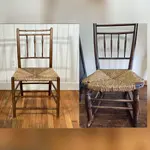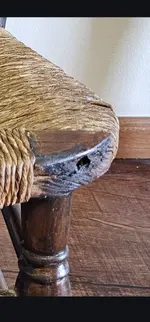You are using an out of date browser. It may not display this or other websites correctly.
You should upgrade or use an alternative browser.
You should upgrade or use an alternative browser.
🔎 UNIDENTIFIED I recently acquired this child's rocking chair and am trying to find out anything about it. If anyone can help I would be most appreciative!
- Thread starter InTheHammock
- Start date
Almy
Bronze Member
- Joined
- Mar 18, 2011
- Messages
- 1,595
- Reaction score
- 3,016
- Golden Thread
- 0
- Location
- Maritime Provinces
- Detector(s) used
- Tesoro Cibola
- Primary Interest:
- Other
Just from what I observe it is made of hardwood, probably ash. I can see the annual rings but no big oak rays. The slight irregularities in the turnings suggest handmade rather than factory made. The wear in some places, notably on the back (where a person's back would rest against it) suggest refinishing using aggressive sandpaper. It has a nice design and is well built. Someone may recognize a more precise type that would help date it. I think it is from the late 1800s, but that is a guess.
Upvote
1
InTheHammock
Tenderfoot
- #3
Thread Owner
Almy, Thank You so very much for all this valuable information!! You are so Much Appreciated!!Just from what I observe it is made of hardwood, probably ash. I can see the annual rings but no big oak rays. The slight irregularities in the turnings suggest handmade rather than factory made. The wear in some places, notably on the back (where a person's back would rest against it) suggest refinishing using aggressive sandpaper. It has a nice design and is well built. Someone may recognize a more precise type that would help date it. I think it is from the late 1800s, but that is a guess.
Upvote
0
InTheHammock
Tenderfoot
- #5
Thread Owner
Thank you for replying. Yes I've tried and the biggest difference I see when doing so is that the area where the legs meet the seat in mine are different than what I'm finding online. The photos I'm finding show the legs raised a bit or more above the seat surface, If that makes sense! I don't know if that's perhaps a difference in time of making or not? Here's a photo comparing the two seat/leg areas, and a close-up of mine...Have you tried the google photo search, I’m not a fan of google, but it can put you in the ballpark of what it is and what it’s worth.
Attachments
Last edited:
Upvote
1
Almy
Bronze Member
- Joined
- Mar 18, 2011
- Messages
- 1,595
- Reaction score
- 3,016
- Golden Thread
- 0
- Location
- Maritime Provinces
- Detector(s) used
- Tesoro Cibola
- Primary Interest:
- Other
I've seen both styles on old chairs. Ones like yours, with the legs inserted into the seat, often have solid wood seats, hollowed to fit the buttocks but with no caning like yours has. Just a thick single piece of wood for the seat. I think you need someone who is a real specialist in antique chairs to answer your dating query with confidence. This may not be the site for that.
Upvote
0
InTheHammock
Tenderfoot
- #7
Thread Owner
Thank you so very much for all your input Almy!I've seen both styles on old chairs. Ones like yours, with the legs inserted into the seat, often have solid wood seats, hollowed to fit the buttocks but with no caning like yours has. Just a thick single piece of wood for the seat. I think you need someone who is a real specialist in antique chairs to answer your dating query with confidence. This may not be the site for that.
Upvote
0
Similar threads
- Question
🔎 UNIDENTIFIED
I need help identifying a druggist bottle from DC
- Replies
- 1
- Views
- 359
Users who are viewing this thread
Total: 1 (members: 0, guests: 1)





